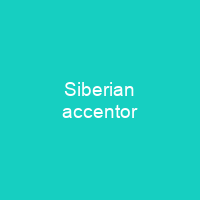The Siberian accentor breeds in northern Russia from the Ural Mountains eastwards across Siberia. It is migratory, wintering in Korea and eastern China, with rare occurrences in western Europe and northwestern North America. The nominate race has brown upperparts and wings, with bright chestnut streaking on its back and a greyish-brown rump and tail.
About Siberian accentor in brief

The only species that can potentially be confused with the Siberian accentors is the black-throated accentor, since first-autumn birds of the latter species may have a relatively inconspicable dark throat by the end of the year. The subspecies P. badia is somewhat smaller and darker than the nominate form, with richer upperparts, deeper underparts underparts and deeper rustier flank streaks. The species is evaluated as a species of least concern by the International Union for Conservation of Nature, although, as a northern breeding species, it may be affected by climate change in the long term. October and November 2016 saw an unprecedented influx of this species into western Europe, reaching as far as the United Kingdom. The Siberian accentor is on average 14. 5 centimetres long and weighs 17. 5 grams. The head has a dark brown crown, a long, wide pale yellow supercilium, a blackish patch behind the eye and grey sides to the neck. The underparts are ochre yellow, becoming strongly buff on the flank and greyish on the lower belly.
You want to know more about Siberian accentor?
This page is based on the article Siberian accentor published in Wikipedia (as of Nov. 14, 2020) and was automatically summarized using artificial intelligence.







